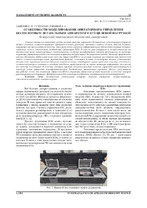| dc.contributor.author | Савёлов, П. И. | |
| dc.contributor.author | Гу, Пэнхао | |
| dc.contributor.author | Лобатый, А. А. | |
| dc.coverage.spatial | Минск | ru |
| dc.date.accessioned | 2023-03-14T10:38:11Z | |
| dc.date.available | 2023-03-14T10:38:11Z | |
| dc.date.issued | 2022 | |
| dc.identifier.citation | Савёлов, П. И. Особенности моделирования операторного управления беспилотным летательным аппаратом и его целевой нагрузкой = Features of simulation of operator control of unmanned aerial vehicle and its target load / П. И. Савёлов, Пэнхао Гу, А. А. Лобатый // Системный анализ и прикладная информатика. – 2022. – № 4. – С. 23-28. | ru |
| dc.identifier.uri | https://rep.bntu.by/handle/data/126529 | |
| dc.description.abstract | Статья посвящена постановке задачи синтеза системы управления беспилотным летательным аппаратом (БЛА) с участием человека-оператора. Проводится анализ различных подходов к синтезу систем, моделей человека-оператора, как звена следящей системы, математических моделей и информационного обеспечения сложных человеко-машинных систем, компетенций, необходимых операторам БЛА. В системе рассматривается человек-оператор как динамическое звено, осуществляющее компенсационное слежение за информацией, которая представлена на мониторе оператора, управляющего БЛА или его целевой нагрузкой в соответствии с поставленной задачей. На основе проведенного анализа обоснована обобщенная схема системы управления БЛА и его целевой нагрузкой, исследована математическая модель человека-оператора в виде передаточной функции, состоящей из пяти элементарных звеньев, учитывающих динамические характеристики центральной нервной системы, запаздывание нервно-мышечной системы, способности человека-оператора сглаживать случайные колебания, представляемой на экране монитора информации, получаемой от системы телеметрии. В качестве типового примера человеко-машинной системы управления рассматривается наземный пункт управления многофункционального беспилотного авиационного комплекса «Бусел», включающего два рабочих места для оператора управления БЛА и оператора управления целевой нагрузкой, в качестве которой рассматривается аппаратура, предназначенная для мониторинга объектов, находящихся на земной поверхности. | ru |
| dc.language.iso | ru | ru |
| dc.publisher | БНТУ | ru |
| dc.title | Особенности моделирования операторного управления беспилотным летательным аппаратом и его целевой нагрузкой | ru |
| dc.title.alternative | Features of simulation of operator control of unmanned aerial vehicle and its target load | ru |
| dc.type | Article | ru |
| dc.identifier.doi | 10.21122/2309-4923-2022-4-23-28 | |
| local.description.annotation | The article is devoted to the formulation of the problem of synthesis of the control system of an unmanned aerial vehicle (UAV) with the participation of a human operator. An analysis is made of various approaches to the synthesis of systems, models of a human operator as a link in a tracking system, mathematical models and information support for complex human-machine systems, competencies required by UAV operators. The system considers a human operator as a dynamic link that performs compensatory monitoring of the relevant information that is presented on the monitor of the corresponding operator controlling the UAV or its target load in accordance with the task. On the basis of the analysis, a generalized scheme of the UAV control system and its target load is substantiated, a mathematical model of a human operator is studied in the form of a transfer function consisting of five elementary links that take into account the dynamic characteristics of the central nervous system, the delay of the neuromuscular system, the ability of the human operator to smooth random fluctuations of the information presented on the monitor screen received from the telemetry system. As a typical example of a human-machine control system, the ground control point of the multifunctional unmanned aerial complex “Busel” is considered, which includes two workplaces for the UAV control operator and the target load control operator, which is considered equipment designed to monitor objects located on the earth’s surface. | ru |

